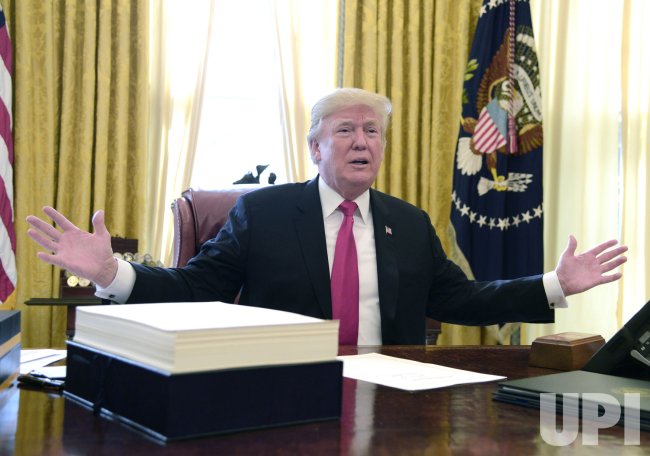The Trump Tax Cut Bill: A Breakdown Of The House Republican Proposal

Table of Contents
Individual Income Tax Changes
The Trump Tax Cut Bill significantly altered the individual income tax system. These changes affected tax brackets, deductions, and credits, impacting taxpayers across various income levels.
Tax Bracket Modifications
The bill reduced individual income tax rates. Here's a comparison:
- Before the Bill: Higher marginal tax rates existed for upper-income earners.
- After the Bill: Seven tax brackets remained, but the rates were lowered. For example, the top rate dropped from 39.6% to 37%.
This resulted in:
- Impact on Different Income Levels: Lower- and middle-income taxpayers saw modest tax cuts, while higher-income individuals benefited more significantly.
- Analysis of Marginal Tax Rates: The reduction in marginal tax rates aimed to stimulate economic activity by encouraging investment and spending.
Standard Deduction and Personal Exemptions
The Trump Tax Cut Bill made substantial changes to deductions:
- Increased Standard Deduction: The standard deduction was nearly doubled, simplifying tax filing for many individuals.
- Elimination of Personal Exemptions: Personal exemptions, previously claimed for each taxpayer and dependent, were eliminated.
This led to:
- Impact on Families: While the increased standard deduction benefited some families, the elimination of personal exemptions could negatively impact larger families.
- Comparison with Previous Tax Laws: The changes marked a significant departure from prior tax laws, favoring simplification over targeted deductions.
Child Tax Credit Adjustments
The bill also expanded the Child Tax Credit (CTC):
- Increased Credit Amount: The maximum CTC increased.
- Eligibility Requirements: While the credit amount increased, some eligibility requirements remained.
- Impact on Families with Children: The expanded CTC provided significant tax relief to families with children.
Corporate Tax Rate Reductions
A cornerstone of the Trump Tax Cut Bill was the significant reduction in the corporate tax rate.
Lowering the Corporate Tax Rate
The most dramatic change was the reduction in the corporate tax rate from 35% to 21%.
- Proposed Corporate Tax Rate Percentage: This 21% rate was significantly lower than rates in many other developed countries.
- Comparison to Previous Corporate Tax Rates: This represented a historical low in the U.S. corporate tax rate.
- Potential Impact on Corporate Profits and Investments: Supporters argued this would boost corporate profits, leading to increased investment and job creation.
- Repatriation of Overseas Profits: The bill also included provisions to encourage the repatriation of overseas corporate profits, further stimulating the economy, though this had mixed results.
Impact on the National Debt and Deficit
The Trump Tax Cut Bill’s impact on the national debt and deficit remains a subject of ongoing debate.
Projected Changes to the National Debt
- Analysis of Government Revenue Projections: The tax cuts significantly reduced federal government revenue.
- Potential Impact on Future Government Spending: The reduced revenue raised concerns about the long-term sustainability of government programs.
- Economic Forecasts Associated with the Tax Cuts: Forecasts varied widely, with some predicting increased economic growth offsetting revenue losses, while others foresaw a significant increase in the national debt.
Economic Impact and Growth Projections
- Discussions on Job Creation: Proponents claimed the tax cuts would stimulate job creation. However, the link between the tax cuts and job growth is debated.
- GDP Growth Estimates: Estimates of GDP growth varied, with some suggesting a modest increase while others remained skeptical.
- Arguments for and against the bill’s economic effectiveness: The debate continues regarding the long-term economic effects of the tax cuts, with both proponents and critics offering supporting data and economic models.
Criticisms and Controversies
The Trump Tax Cut Bill faced significant criticism from various groups.
Concerns about Income Inequality
Critics argued that the tax cuts disproportionately benefited high-income earners, exacerbating income inequality. The lower tax rates for corporations and wealthy individuals were seen as worsening the existing wealth gap.
Arguments against its Long-Term Sustainability
The bill's long-term fiscal sustainability was a major point of contention. Many experts expressed concern about the significant reduction in government revenue, potentially leading to increased deficits and a larger national debt over time. This long-term impact remains a subject of considerable debate and further analysis.
Conclusion
The Trump Tax Cut Bill significantly reshaped the American tax code. Its impact, both positive and negative, continues to be debated. While proponents emphasized potential economic growth, critics highlighted concerns about income inequality and long-term fiscal sustainability. To fully grasp the complexities of this transformative legislation, further research into the Trump Tax Cut Bill and its effects is essential. Understanding its provisions remains vital for financial planning and informed civic engagement.

Featured Posts
-
 Pivotal Character Killed In Elsbeth Season 2 Episode 18
May 13, 2025
Pivotal Character Killed In Elsbeth Season 2 Episode 18
May 13, 2025 -
 Perkembangan Terbaru Upaya Myanmar Memberantas Judi Online Dan Penipuan Telekomunikasi
May 13, 2025
Perkembangan Terbaru Upaya Myanmar Memberantas Judi Online Dan Penipuan Telekomunikasi
May 13, 2025 -
 Predlozheniya Deputatov Dlya Predvybornoy Programmy Edinoy Rossii
May 13, 2025
Predlozheniya Deputatov Dlya Predvybornoy Programmy Edinoy Rossii
May 13, 2025 -
 Obituaries Saying Goodbye To Our Neighbors
May 13, 2025
Obituaries Saying Goodbye To Our Neighbors
May 13, 2025 -
 Fine Arts Professorship A Focus On Spatial Design And Theory
May 13, 2025
Fine Arts Professorship A Focus On Spatial Design And Theory
May 13, 2025
